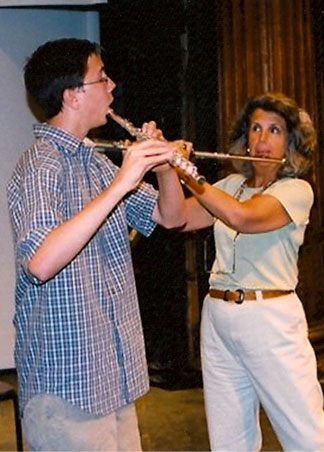Jeanne Baxtresser’s Ten Commandments
By Michel Debost
Flute Talk—March 1996
Long ago, when I was a student, I did not always have a clear idea of the orchestral excerpts I studied. Despite the prevalence of tape decks, C.D.s, and good libraries, many students today are clueless about the cultural, poetic, and historic background of the well-known excerpts. Students are not entirely at fault because the available books, on either side of the Atlantic, usually print the flute line without indicating the musical context. The same thing happens when preparing for auditions: even if the flutist may not know the score completely, he should at least know what is happening during the famous flute solos.
A new book fills that need: Orchestral Excerpts for Flute (Theodore Presser), written by Jeanne Baxtresser, principal flute of the New York Philharmonic, with piano reductions by Martha Rearick. Several of the novel features in this publication are the brief musical explanations before each excerpt, and comments on its historical context, with literary references and translations when appropriate in works by Bach (St. Matthew’s Passion and Great Mass), Mahler (Das Lied von der Erde), and Gluck (Blessed Spirits). The original orchestral parts are reproduced with ample space. Baxtresser corrects obvious misprints in Beethoven, Hindemith, and explains ambiguities in Daphnis and Peter and the Wolf in her commentary. Facsimile reproductions accompany the scores of Debussy’s L’Après-Midi d’une Faune and the fourth movement of Brahms’ Symphony #4 so flutists can sense the emotions behind the pen of these masterpieces.
Martha Rearick, pianist, flutist, and arranger, reduces the orchestral scores for piano and indicates the original instrumentation without complicating the accompaniment, a problem found in many concerto reductions. When appropriate, other instrument lines are included in the piano score (the oboe in Der Abschied; the piccolo in Firebird, Variations de L’Oiseau de Feu.)
The secrets to performing these orchestral solos are sometimes found in the translation of German terms or in the vocal lines of Bach and Mahler (Das Lied, a poetically poignant flute part too rarely requested at auditions.) Baxtresser provides these plus fingerings, for example, to relieve the diabolical final of Prokofiev’s Classical Symphony. She also gives practical performance hints for breathing and capturing the proper mood and spirit.
Unlike some players, I still enjoy working on orchestral excerpts, although audition time is well behind me, because they focus on a short but specific difficulty in great music. Beethoven’s Leonore and Eroica require clear articulation and rhythm. Bizet’s L’Arlesienne calls for purity of sound while slurring in the third register and accurate intonation. Musical pacing and phrasing with tension and release are the important aspects of the finale of Brahms’ Symphony #4, while in Debussy’s L’Après-Midi d’une Faune it is controlling the breath and creating color shading.
In Gluck’s Blessed Spirits flutists should concentrate on pacing within the structure and expressive playing. Contrasting this is the steady staccato articulation in the low register in Mendelssohn’s Scherzo. Speed, concentration, and alternate fingerings are the focus of Prokofiev’s Classical Symphony, while soft legato and control dominate Ravel’s Bolero. Tonal colors and high-register smoothness should be the aim in Daphnis, and on the opposite end of the playing spectrum are flying staccato with finger synchronization and elegance in Saint-Saëns’ Carnival of the Animals. All of Strauss’ Till Eulenspiegel’s Lustige Streiche requires concentration, expert reading, and will power.
In the introduction of her book, Baxtresser offers advice for auditioning successfully and professional behavior. I call these her Ten Commandments:
- Learn the entire piece.
- Concentrate on impeccable rhythm and accurate intonation.
- Regard seriously all musical and tempo markings and articulations.
- A performance represents what you are at a particular point in time.
- Don’t trivialize the event by dressing down.
- Practice with a tuner, but be willing to adjust in any direction while playing in a group.
- Refrain from any negative reactions about your playing or that of others.
- Give the conductor your eyes.
- Show that you are capable of anything requested from the podium.
- Strive for expressiveness without sentimentality.
Henceforth, flutists will have no excuse for not knowing the meaning of a German phrase or what instrument accompanies the flute. Read the book to find out what Daphnis and Chloe are doing in the famous solo and if the first scale should have an E# or E♮; learn about Till Eulenspiegel, what instrument accompanies the final flute solo in Eroica, and who the flute accompanies in William Tell. All these answers and more are at your fingertips for only $40, a fair price considering the wealth of information and love that went into this book.
Michel Debost, former principal flutist of the Orchestre de Paris and professor of flute at the Paris Conservatory, currently teaches at the Oberlin Conservatory of Music in Oberlin, Ohio and presents masterclasses and recitals throughout the country and abroad.
Sam Borodkin was a percussionist in the New York Philharmonic. At one rehearsal Stokowski endlessly rehearsed a woodwind passage. Borodkin who was playing triangle, crossed his arms and fell asleep. Finally satisfied with the woodwinds, Stokowski decided to go on. When the triangle entrance came and went in silence, Stokowski yelled, “Triangle!” Borodkin woke up and without hesitation said, “Louder, Maestro?” —told by Harvey Phillips


